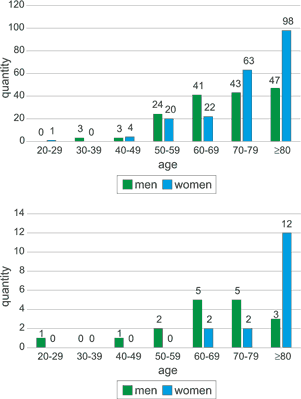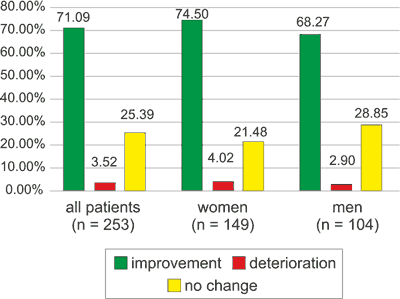*Katarzyna Kapica-Topczewska1, Weronika Golec2, Joanna Kulikowska3, Jakub Izycki-Herman3, Adam Gryko3, Malgorzata Wasilewska3, Magdalena Kowalczyk3, Anna Dabrowska3, Weronika Wozniak3, Agata Czarnowska1, Jan Kochanowicz1, Alina Kulakowska1
Analysis of risk factors and clinical characteristic of stroke patients admitted to the Department of Neurology, Medical University of Bialystok in 2016
Analiza czynników ryzyka i charakterystyka kliniczna pacjentów z udarem mózgu hospitalizowanych w Klinice Neurologii UM w Białymstoku w 2016 roku
1Department of Neurology, Medical University of Bialystok, Poland
2University Clinical Hospital of Bialystok, Poland
3Department of Neurology, Students’ Scientific Groups, Medical University of Bialystok, Poland
Streszczenie
Wstęp. Udar mózgu jest główną przyczyną niepełnosprawności oraz drugą co do częstości przyczyną zgonów na świecie. Każdego roku w Polsce rozpoznawanych jest ponad 60 tys. przypadków udaru mózgu. W nadchodzących latach, z powodu starzenia się społeczeństwa i wzrostu występowania czynników ryzyka, takich jak: nadciśnienie tętnicze, dyslipidemia i migotanie przedsionków, spodziewany jest dalszy wzrost zapadalności na udary mózgu w Polsce.
Cel pracy. Analiza demograficzna i kliniczna oraz ocena czynników ryzyka występujących u pacjentów z udarem mózgu hospitalizowanych w Klinice Neurologii UMB.
Materiał i metody. Analizie retrospektywnej poddano dokumentację medyczną pacjentów hospitalizowanych z powodu udaru mózgu w Klinice Neurologii UMB w 2016 roku. Stan neurologiczny chorych oceniono przy przyjęciu i wypisie, wykorzystując Skalę Udarową Narodowego Instytutu Zdrowia (National Institutes of Health Stroke Scale – NIHSS).
Wyniki. Przeanalizowano dokumentację 402 pacjentów z udarem mózgu, w tym 55,47% kobiet i 44,53% mężczyzn. Udary niedokrwienne stanowiły 91,8%, a krwotoczne 8% przypadków. Średni wiek zachorowania na udar mózgu wyniósł 74,2 roku (u kobiet 76,6 roku, u mężczyzn 71,2 roku). Najczęściej występującymi czynnikami ryzyka były: nadciśnienie tętnicze (78,6%), dyslipidemia (55,2%) i migotanie przedsionków (25,6%). Według skali NIHSS przy przyjęciu ≤ 5 pkt otrzymało 65%, a ≥ 25 pkt – 1,8% pacjentów. Podczas hospitalizacji poprawę kliniczną w skali NIHSS osiągnięto u 71,9%, pogorszenie u 3,6% oraz brak zmian u 24,5% pacjentów. Śmiertelność wewnątrzszpitalna wyniosła 7,5%, z powodu udaru niedokrwiennego mózgu zmarło 6,78%, a krwotocznego – 15,15% pacjentów.
Wnioski. Ponad 2/3 pacjentów było obciążonych więcej niż jednym czynnikiem ryzyka udaru mózgu, z których najczęstszym było nadciśnienie tętnicze. Znajomość modyfikowalnych czynników ryzyka udaru mózgu jest niezbędna celem włączenia profilaktyki wtórnej.
Summary
Introduction. Stroke is the main cause of disability and the second leading cause of death worldwide. Over 60,000 cases of stroke are diagnosed in Poland each year. In the coming years, due to the aging of the population and the elevation of risk factor prevalence, a further increase in the incidence of stroke in Poland is expected.
Aim. Investigation of demographic characteristics, clinical analysis and assessment of risk factors among the stroke patients hospitalized in the UMB Department of Neurology.
Material and methods. The retrospective analysis included medical documentation of patients hospitalized due to a stroke in 2016. The neurological condition of patients was assessed at the time of admission and discharge using the National Institutes of Health Stroke Scale (NIHSS).
Results. The medical documentation of 402 stroke patients, consisting of 55.47% women and 44.53% men was analyzed. Ischemic (IS) and haemorrhagic strokes (HS) accounted for 91.8 and 8% respectively. The average age of a stroke patient was 74.2 years (women 76.6, men 71.2). The most common risk factors were hypertension (78.6%), dyslipidemia (55.2%) and atrial fibrillation (25.6%). According to the NIHSS scale, 65% of patients received ≤ 5 while 1.8% ≥ 25 points. During hospitalization, the NIHSS clinical improvement was achieved in 71.9%, deterioration in 3.6% and no change was observed in 24.5% of patients. In-hospital mortality amounts to 7.5%.
Conclusions. More than two thirds of patients had more than one stroke risk factor, from which the most common one is hypertension. Awareness of modifiable risk factors for stroke is essential for implementation of a secondary prevention.

INTRODUCTION
Stroke is the second cause of death, after an ischemic heart disease, and it is the leading cause of disability in the adult population (1). It is estimated that annually 15 million people suffer from a stroke worldwide, of which 5 million die, and another 5 million suffer from disability (2). The incidence of stroke in highly developed countries remains relatively stable, while in developing countries, it is still growing (3). Poland invariably has a high stroke incidence rate, which in 2015 amounted to over 60,000 patients (4). The probability of stroke is significantly related to the presence of risk factors. These include the non-modifiable (sex, age, history of stroke, ethnic determinants, genetic burden) and modifiable factors (arterial hypertension, heart disease, diabetes and obesity) (5). In addition, many patients are affected by more than one risk factor, which further increases the risk of stroke (6). Due to the aging of the population and an increase in the incidence of these factors, an increase in the number of strokes in Poland is expected in the coming years (7).
AIM
The aim of this work was the demographic and clinical analysis, including assessment of risk factors, of stroke patients hospitalized in the Department of Neurology of Medical University in Bialystok during the calendar year.
MATERIAL AND METHODS
A retrospective study was conducted on a group of 402 patients diagnosed with ischemic or hemorrhagic stroke admitted to the Department of Neurology of the Medical University of Bialystok from January 1 to December 31, 2016. The diagnosis of stroke in all cases was based on a computed tomography of the head. Patients with post-traumatic haemorrhage or bleeding into a brain tumor were excluded form the study. The demographic and clinical data were obtained from the patients’ medical records. As dyslipidemia, one of four criteria was adopted: increased cholesterol level or concentration, increased triglycerides (TG), increased low density lipoprotein (LDL) or previously used statin therapy. The neurological status of the patients was evaluated on the day of admission and discharge according to the NIHSS scale. The neurological deficit was defined as a minor in the case of NIHSS ≤ 5, moderate NIHSS > 5 and < 25, and severe NIHSS ≥ 25. Improvement in the patients’ condition was defined as a decrease in the NIHSS score by ≥ 1, while the deterioration as an increase of the NIHSS score by ≥ 1 compared to the time of admission.
The consent for conducting the study was issued by the Bioethical Commission of the Medical University of Bialystok.
RESULTS
The studied population consisted of 402 patients hospitalized in the UMB Department of Neurology, including 91.8% patients with ischemic and 8.2% with hemorrhagic stroke (fig. 1). Women accounted for more than half of the hospitalized patients (55.47%). Both women and men were significantly dominated by ischemic stroke (92.83% in women vs. 90.5% in men).

Fig. 1. Incidence of ischemic and hemorrhagic stroke depending on age and gender
The average age of stroke incidence was 74.2 years (23-97). The age of the men, was on average 5 years lower than women (71.2 vs. 76.6 years). The average age of onset of hemorrhagic stroke among women and men was lower than of ischemic stroke (67.7 vs. 74.2 years). Patients above the age of 60 years accounted for 84.8% of the studied population. In this age group, the majority of patients (57.48%) were women, while men (52.63%) predominated in the group below the age of 60 years. More than a half of the patients (55.47%) lived in urban areas. A minor neurological deficit, according to the NIHSS scale was found in 65% of patients, including 57.1% of women and 42.9% of men. A severe neurological deficit was reported in 1.8% of patients. At the time of discharge a clinical improvement was obtained in 71.9% of all patients (74.5% of women, 66.4% of men), clinical deterioration in 3.6% (4.02% of women, 2.1% of men), and in 24,5% (21.48% women, 30.8% men) no change in neurological status was observed (fig. 2).

Fig. 2. Neurological status of patients hospitalized due to a stroke according to the NIHSS scale
Powyżej zamieściliśmy fragment artykułu, do którego możesz uzyskać pełny dostęp.
Mam kod dostępu
- Aby uzyskać płatny dostęp do pełnej treści powyższego artykułu albo wszystkich artykułów (w zależności od wybranej opcji), należy wprowadzić kod.
- Wprowadzając kod, akceptują Państwo treść Regulaminu oraz potwierdzają zapoznanie się z nim.
- Aby kupić kod proszę skorzystać z jednej z poniższych opcji.
Opcja #1
24 zł
Wybieram
- dostęp do tego artykułu
- dostęp na 7 dni
uzyskany kod musi być wprowadzony na stronie artykułu, do którego został wykupiony
Opcja #2
59 zł
Wybieram
- dostęp do tego i pozostałych ponad 7000 artykułów
- dostęp na 30 dni
- najpopularniejsza opcja
Opcja #3
119 zł
Wybieram
- dostęp do tego i pozostałych ponad 7000 artykułów
- dostęp na 90 dni
- oszczędzasz 28 zł
Piśmiennictwo
1. Feigin VL, Krishnamurthi RV, Parmar P et al.; GBD 2013 Writing Group; GBD 2013 Stroke Panel Experts Group: Update on the Global Burden of Ischemic and Hemorrhagic Stroke in 1990-2013: The GBD 2013 Study. Neuroepidemiology 2015; 45(3): 161-176.
2. Sacco RL, Kasner SE, Broderick JP et al.; American Heart Association Stroke Council, Council on Cardiovascular Surgery and Anesthesia; Council on Cardiovascular Radiology and Intervention et al.: An updated definition of stroke for the 21st century. Stroke 2013; 44(7): 2064-2089.
3. Norrving B, Kissela B: The global burden of stroke and need for a continuum of care. Neurology 2013; 80(3, suppl. 2): S5-12.
4. Wilkins E, Wilson L, Wickramasinghe K et al.: European Cardiovascular Disease Statistics 2017. European Heart Network 2017: 192.
5. Boehme AK, Esenwa C, Elkind MSV: Stroke Risk Factors, Genetics, and Prevention. Circulation Research 2017; 120(3): 472-495.
6. Pezzini A, Grassi M, Del Zotto E et al.: Cumulative effect of predisposing genotypes and their interaction with modifiable factors on the risk of ischemic stroke in young adults. Stroke 2005; 36(3): 533-539.
7. Labuz-Roszak B, Skrzypek M, Pierzchała K et al.: Secondary prevention of stroke in elderly people in Poland – results of PolSenior study. Neurol Neurochir Pol 2014; 48(2): 85-90.
8. Feigin VL, Roth GA, Naghavi M et al., Global Burden of Diseases, Injuries and Risk Factors Study 2013 and Stroke Experts Writing Group: Global burden of stroke and risk factors in 188 countries, during 1990-2013: a systematic analysis for the Global Burden of Disease Study 2013. Lancet Neurol 2016; 15(9): 913-924.
9. Piepoli MF, Hoes AW, Agewall S et al.; ESC Scientific Document Group: 2016 European Guidelines on cardiovascular disease prevention in clinical practice. Eur Heart J 2016; 37(29): 2315-2381.
10. Strepikowska A, Buciński A: Udar mózgu – czynniki ryzyka i profilaktyka. Postępy Farmakoterapii 2009; 65(1): 46-50.
11. Benjamin EJ, Virani SS, Callaway CW et al., American Heart Association Council on Epidemiology and Prevention Statistics Committee and Stroke Statistics Subcommittee: Heart Disease and Stroke Statistics-2018 Update: A Report From the American Heart Association. Circulation 2018; 137(12): e67-e492.
12. Syta-Krzyżanowska A, Chorąży M, Drozdowski W: Etiological characteristics of strokes treated in the Department of Neurology of the Medical University of Bialystok with the analysis of risk factors. Polish Aktualn Neurol 2010; 10: 26-30.
13. Starostka-Tatar A, Labuz-Roszak B, Skrzypek M et al.: Characteristics of hospitalizations due to acute stroke in the Silesian Province, Poland, between 2009 and 2015. Neurol Neurochir Pol 2017; pii:S0028-S3843.
14. O’Donnell MJ, Xavier D, Liu L et al.; INTERSTROKE investigators: Risk factors for ischaemic and intracerebral haemorrhagic stroke in 22 countries (the INTERSTROKE study): a case-control study. Lancet 2010; 376: 112-123.
15. Boehme AK, Esenwa C, Elkind MSV: Stroke Risk Factors, Genetics, and Prevention. Circulation Research 2017; 120(3): 472-495.
16. Niewada M, Skowronska M, Ryglewicz D et al.: Acute ischemic stroke care and outcome in centers participating in the Polish National Stroke Prevention and Treatment Registry. Stroke 2006; 21: 1837-1843.
17. Goldstein LB, Amarenco P, Lamonte M et al.: SPARCL Investigators. Relative effects of statin therapy on stroke and cardiovascular events in men and women: secondary analysis of the Stroke Prevention by Aggressive Reduction in Cholesterol Levels (SPARCL) Study. Stroke 2008; 39(9): 2444-2448.


